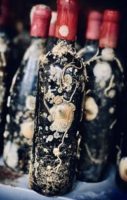
Retrieved submerged bottles of Ocean Fathoms wine.
Image: Lara Castaognia
A new craze is spreading across the world of wine. Call it “shipwreck wine” without the shipwreck. Off the shores of California, Croatia, Spain, Britain, France, Argentina, Italy, and China; vintners are aging wines underwater in specially constructed ocean wine cellars. They report that the ocean-aged wines mature faster and, depending on the wine, were brighter and fruitier. The near-constant cool temperature underwater coupled with the total lack of oxygen is credited with the improved quality of the wine when it emerges from the briny deep.
The underwater wine cellars around the globe were inspired by the discovery of a shipwreck in the Baltic in 2010. In the wreck’s hold, divers found 30 bottles of champagne thought to pre-date the French Revolution on the Baltic seabed. Remarkably, the champagne was still highly drinkable. When the Baltic bubbly sold at auction, a bottle of Veuve Clicquot, believed to date from between 1782 and 1788, went for 30,000 euros or roughly $43,500.
Obviously, the wines in the new underwater wine cellars are not left for more than 150 years like the shipwreck champagne. Most are aged underwater for between several months to a full year.
The Robb Report asks the critical question: “But how do they taste?” Wapisa owner Patricia Ortiz describes her submerged wine as “rounder, more elegant and with fresher fruit.” Azzaretto, who sunk his first bottles in 2015, is equally convinced, as is his Ocean Fathoms partner Rajat Parr, a sommelier and winemaker whose first experience with ocean-aged wine was selling a bottle of 1907 Heidsieck Monopole Gout Americain, recovered from a different shipwreck, for $4,700 when he worked at the restaurant Michael Mina, in San Francisco. Of that wine, he recalls, “The acidity was well-preserved, and overall, the wine was surprisingly lively.”
Wine expert and author Mark Oldman admits to being skeptical when he was invited to try an ocean-aged cuvée at Leclerc Briant, in Épernay, France. “I wasn’t sure it would have a different personality from their other Champagnes, but it did,” he says, adding that the zesty “life force” of the wines convinced him to carry several bottles back home to the US.
The one major problem with wines aged in underwater cellars is the cost. The expense of the preparation, equipment, and time involved, plus the caché of the novelty of the wine, all add to the price tag. For example, M. Hostomme Abysse, a Grand Cru Brut, that spend the last year of its maturation submerged in 200 feet of water off the coast of a remote island in Southern France sells for $1,900 a bottle.
At those prices, I may stick to rum.
Thanks to Irwin Bryan for contributing to this post.

Does anyone remember the monkeys painting modern art in the 70s or the fable of The Kings New Clothes?
There’s a bottle of cheap sparkling wine in the bilges of my Nic 32 in case we ever need to celebrate actually getting anywhere. Do you think it will have improved?